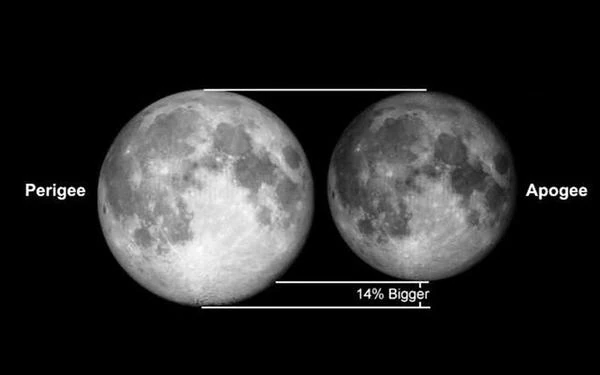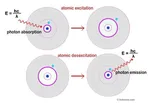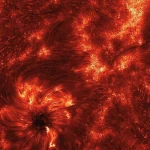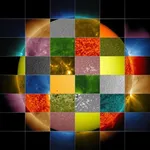The Moon Illusion
Moon Illusion
You have all seen a huge full moon rising on the horizon just above the houses of our cities. The observation is surprising because it seems that the moon is huge, this famous optical illusion has no straightforward explanation. If we take a ruler and you measure the apparent size of the moon when near the horizon, and when it is high in the sky, we obtain the same extent, there is no difference.
Why our brain recreates a different picture of reality?
One explanation (still unclear) is that when we look at buildings or trees on the horizon, our brain interprets a distance not so far away.
When the moon is on the same horizon, the brain assumes that the Moon is also on this same distance scale, and amplifies its size.
Conversely, when the moon is high in the sky, the brain compensates for this by making distance seem smaller.
However the Moon moves in an elliptical orbit like all cosmic objects and its distance from Earth varies.
At its apogee, the farthest point from Earth, is at 405 696 km, while at its perigee, it is 356 410 km.
Of course when it is at its perigee, it appears larger, more exactly 14%, 14% is the difference between the two apsis (points nearest and farthest) the orbit of the Moon relative to Earth. But the illusion of great Moon occurs as well for the apogee than the perigee.
NB: We feel that our Moon is very far from Earth, but if you wanted to travel this distance by car on a highway at 130 km/h, we would have only 115 days.
Image: Difference in the apparent size of the moon between apogee and perigee. At perigee (left), the Moon is 14% greater than apogee (right).

 Sprites and Cosmic Rays: The Ghostly Lightning of the Atmosphere
Sprites and Cosmic Rays: The Ghostly Lightning of the Atmosphere  Principle of
absorption and emission of a photon
Principle of
absorption and emission of a photon  The Femtosecond Laser: From Ultra-Short Time to Extreme Power
The Femtosecond Laser: From Ultra-Short Time to Extreme Power  The World of Color
The World of Color  The colors of the rainbow
The colors of the rainbow  The Nature of Light
The Nature of Light  Plasma Lamp and Field Concept
Plasma Lamp and Field Concept  What is Vantablack?
What is Vantablack?  Michelson-Morley Experiment
Michelson-Morley Experiment  Redshift calculation (z)
Redshift calculation (z)  Spectacular airglow in France
Spectacular airglow in France  All the Light of the Electromagnetic Spectrum
All the Light of the Electromagnetic Spectrum  Solar Pillars: Celestial Mirages and Light Phenomena
Solar Pillars: Celestial Mirages and Light Phenomena  The Speed of Light: A Universal Constant
The Speed of Light: A Universal Constant  The incredible precision of the second
The incredible precision of the second  Effects of light aberration
Effects of light aberration  Why do elementary particles have no mass?
Why do elementary particles have no mass?  Polar Auroras: Lights of the Solar Wind
Polar Auroras: Lights of the Solar Wind  Blue Moon or Ice Moon: Understanding These Lunar Phenomena
Blue Moon or Ice Moon: Understanding These Lunar Phenomena  Gravitational Lenses: When Spacetime Becomes a Mirage
Gravitational Lenses: When Spacetime Becomes a Mirage  Optical Illusions: Deceptions and Mysteries of Visual Perception
Optical Illusions: Deceptions and Mysteries of Visual Perception  Traveling Light: How a Photon Leaves the Sun to Reach Earth?
Traveling Light: How a Photon Leaves the Sun to Reach Earth?  Bioluminescence of living organisms
Bioluminescence of living organisms  Laser light
Laser light  We do not see with our eyes but with our brain
We do not see with our eyes but with our brain  Differences between heat and temperature
Differences between heat and temperature  Zodiacal Light: Reflection of Interplanetary Dust
Zodiacal Light: Reflection of Interplanetary Dust  Explanation of the 8 of the analemma
Explanation of the 8 of the analemma  The Antitwilight Arch: Earth's Shadow
The Antitwilight Arch: Earth's Shadow  How many photons to heat a cup of coffee?
How many photons to heat a cup of coffee?  Spectroscopy: A Key to Analyzing the Invisible World
Spectroscopy: A Key to Analyzing the Invisible World  The Cherenkov light
The Cherenkov light  The lights of the Sun
The lights of the Sun  What is a Wave?
What is a Wave?  Planck's equation and black body light
Planck's equation and black body light  Energy Conservation
Energy Conservation